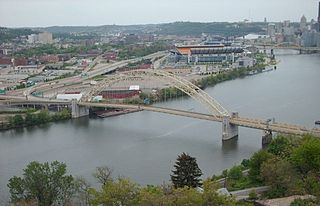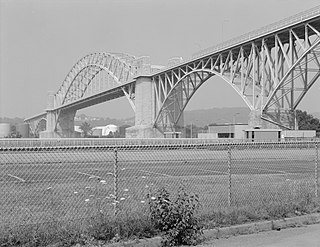
A truss bridge is a bridge whose load-bearing superstructure is composed of a truss, a structure of connected elements, usually forming triangular units. The connected elements may be stressed from tension, compression, or sometimes both in response to dynamic loads. The basic types of truss bridges shown in this article have simple designs which could be easily analyzed by 19th and early 20th-century engineers. A truss bridge is economical to construct because it uses materials efficiently.

The Three Sisters are three similar self-anchored suspension bridges spanning the Allegheny River in downtown Pittsburgh, Pennsylvania at 6th, 7th, and 9th streets, generally running north/south. The bridges have been given formal names to honor important Pittsburgh residents:

The Roberto Clemente Bridge, also known as the Sixth Street Bridge, spans the Allegheny River in downtown Pittsburgh, Pennsylvania, United States.

The Smithfield Street Bridge is a lenticular truss bridge crossing the Monongahela River in Pittsburgh, Pennsylvania, USA.

The Fort Duquesne Bridge is a steel bowstring arch bridge that spans the Allegheny River in Pittsburgh, Pennsylvania. It was colloquially referred to as "The Bridge to Nowhere".

The Sewickley Bridge is a steel continuous truss bridge spanning the Ohio River between Sewickley and Moon Township, Pennsylvania, carrying State Route 4025 and the Orange Belt. It was built by American Bridge Company and opened on October 21, 1981. Its center span is 750 feet (230 m) long and the side spans are each 375 feet (114 m) long. The bridge deck contains two vehicle lanes and a pedestrian sidewalk. It crosses 73 feet (22 m) above the river. The bridge is owned by the Pennsylvania Department of Transportation.

The Birmingham Bridge is a bowstring arch bridge in Pittsburgh, Pennsylvania, which crosses over the Monongahela River. The bridge connects East Carson Street on the South Side with Fifth and Forbes Avenues going to Uptown, Oakland, and the Hill District. It is named in honor of the English city of Birmingham and also for the neighborhood it connects to, which was once called Birmingham, now a part of the South Side. Many locals also may refer to it with its unofficial name, the 22nd Street bridge.

The Hot Metal Bridge is a truss bridge in Pittsburgh, Pennsylvania, that crosses the Monongahela River. The bridge consists of two parallel spans on a single set of piers: the former Monongahela Connecting Railroad Bridge, built in 1887, on the upstream side and the former Hot Metal Bridge, built in 1900, on the downstream side. The Monongahela Connecting Railroad Bridge carried conventional railroad traffic, while the Hot Metal Bridge connected parts of the J&L Steel mill, carrying crucibles of molten iron from the blast furnaces in ladle transfer cars to the open hearth furnaces on the opposite bank to be converted to steel. During World War II 15% of America's steel making capacity crossed over the Hot Metal Bridge, up to 180 tons per hour. The upstream span was converted to road use after a $14.6 million restoration, and opened by Mayor Tom Murphy with a ceremony honoring former steel workers on June 23, 2000. The bridge connects 2nd Avenue at the Pittsburgh Technology Center in South Oakland with Hot Metal Street in the South Side. The downstream span reopened for pedestrian and bicycle use in late 2007 after two years of work. The Great Allegheny Passage hiker/biker trail passes over this bridge as it approaches Pittsburgh's Golden Triangle area.

The Fort Wayne Railroad Bridge, listed as the Pennsylvania Railroad Bridge on the National Register of Historic Places, is a double-deck steel truss railroad bridge spanning the Allegheny River in Pittsburgh, Pennsylvania.

The West End Bridge is a steel tied-arch bridge over the Ohio River in Pittsburgh, Pennsylvania, approximately 1 mile (1.6 km) below the confluence of the Allegheny and Monongahela Rivers. It connects the West End to the Chateau neighborhood on the North Side of Pittsburgh.

The Neville Island Bridge is a tied arch bridge which carries Interstate 79 and the Yellow Belt across the Ohio River and over Neville Island, west of Pittsburgh, Pennsylvania.

The McKees Rocks Bridge is a steel trussed through arch bridge which carries the Blue Belt, Pittsburgh's innermost beltline, across the Ohio River at Brighton Heights and McKees Rocks, Pennsylvania, west of the city.

The David McCullough Bridge, commonly and historically known as the 16th Street Bridge, is a steel trussed through arch bridge that spans the Allegheny River in Pittsburgh, Pennsylvania.

The Tioronda Bridge once carried South Avenue in Beacon, New York, across Fishkill Creek. Built between 1869 and 1873 by the Ohio Bridge Company, it was demolished by the city in December 2006. The bridge had been listed on the National Register of Historic Places in 1976, but a decade later had deteriorated to the point that it had to be closed.

The Brady Street Bridge, also known as the South 22nd Street Bridge, was a steel bowstring arch bridge in Pittsburgh, Pennsylvania, which crossed over the Monongahela River at South 22nd Street. Its main span was a tied arch with a suspended road deck, with two through-truss side spans, carrying two traffic lanes between Brady Street on the Pittsburgh side and South 22nd Street on the south side. Approach viaducts were built at either end. The bridge was built by the Schultz Bridge and Iron Company.

The Fleming Park Bridge is a through truss bridge which spans the back channel of the Ohio River, between Neville Island and Stowe Township, PA. Although the Ohio River's back channel is only 590 feet wide, roughly 660 feet of this newer bridge was erected over water due to the unique 65 degree angle of the structure's trajectory.

The Herr's Island Railroad Bridge, also known as the West Penn Railroad Bridge, is a truss bridge across the Allegheny River in the United States between the Pittsburgh neighborhoods of Troy Hill and Herrs Island.

The Senator Robert D. Fleming Bridge, commonly known as the 62nd Street Bridge, is a truss bridge that carries Pennsylvania Route 8 across the Allegheny River between the Pittsburgh neighborhoods of Morningside and Lawrenceville and Sharpsburg, Pennsylvania.

The Bessemer & Lake Erie Railroad Bridge is a truss bridge that carries the Canadian National Railway's Bessemer and Lake Erie Railroad division across the Allegheny River between the Pittsburgh suburbs of Plum and Harmar Township, Pennsylvania. In 1897, a single-track trestle and viaduct was built on this site; in 1918, the original piers were doubled in width, the current double-tracked structure built alongside, and then slid into place. The original north trestle approach was buried in slag dumped from an adjacent temporary filling trestle.






























